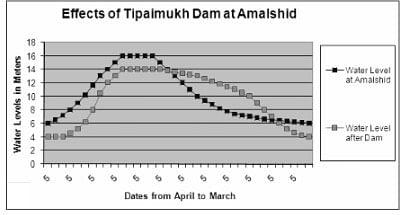Tipaimukh Dam: For whose benefit?

Honourable Foreign Affairs Adviser to the Prime Minister, Mr. Gowher Rizvi, wrote an article in The Daily Star (December 13) on Tipaimukh, and appealed for rational and scientific discussion, rising above emotion or partisanship. He wrote that he had spoken to many experts, environmental scientists, policy makers and politicians from all shades of opinion to understand the impact of the Tipaimukh project prior to traveling to Delhi. They helped him to understand the issues and raised concerns on which he was to seek clarifications and assurances. He met with the key decision makers in India, including the prime minister, and raised those concerns. Finally, he summarised the facts and information he was able to gather in 15 points.
Tipaimukh is on the border of Kolashib district of Mizoram and Churachandpur district of Manipur, where the Tipai (Tuivai) River falls into the Barak River. Here, the Barak River, arriving from northeast through the Kala (Kacha) Naga areas of Manipur, makes a U turn. The Tipai River originates in Myanmar, arriving from the south to fall on this turning point. The Barak River then flows towards the Cachhar district of Assam through the eastern valley of Bhuban Hills. Through the hills and plains of Assam it flows for about 180 km to reach the Bangladesh border point at Amalshid. Here, the river bifurcates into the Surma and Kushiara Rivers to enter Bangladesh. Reacting to the article of the adviser, I am expressing my opinions on his points to make it clear who will benefit from the dam.
Tipaimukh Dam Project is expected to generate 1,500 MW of electricity, which is actually too ambitious a figure. The Barak River upstream of the dam point has catchments of about 12,000 sq km area, with an average annual rainfall of 1,500 mm. The Kaptai Dam in Bangladesh has double the rainfall intensity, double the catchment areas, and double the storage capacity, but can produce only 450 MW. A dam at Tipaimukh will restrict some flood flow towards the lowlands of the Kushiara and Surma valleys in summer, but cannot check monsoon floods because of being at full storage. Anyway, storage in the dam will augment low flows in the rivers during dry months of autumn, winter and spring. But this augmentation shall keep the haors covered in water until February.
Whatever the scientists and hydrologists argue, a hydel reservoir in flood season is kept to full capacity to get the highest output of electricity. As per the design of a dam, the water overflows through its spillway in case of heavy rainfall. Thus, all regulations fail to mitigate flooding in monsoon. This happened this year in Damodar Valley, when the Panchet, Mython, Barakar and Tilaiya hydel dams were over flown and severe floods occurred in Bardhaman, Bankura, Hoogly, and Haora districts. It is true, as Mr. Rizvi observed, that a dam with a reservoir augments the flow of the river in the lean period and does the opposite in the rainy season. It would have been good news to us if the dam was to operate in this manner in Rangpur Division. In Sylhet Division, it is the reason of threat.
The Surma and Kushiara Rivers flow through the haor areas of Sylhet Division. They feed the lowlands with floods during monsoon and drain them in winter. Its ground elevation has a natural slope towards the Tanguar Haor in Sunamganj, which has surrounding elevation about 3m average above mean sea level. The Surma River has catchments in the Garo, Khashia and Jaintia Hills. The flash floods in the haors arrive in April, after any heavy downpour in the Barak valley. A dam at Tipaimukh will restrict some flood flow towards the lowlands of the Kushiara and Surma valleys, if the flood arrives in April. But the dam to produce hydroelectricity will augment low flow in the rivers during autumn, winter and mid-spring. This will restrict drainage of crop lands in haor areas from December to February. Bangladesh will lose boro crops worth Tk.1,000 crore per year because of this.
A barrage is planned at Fulertal in Cahhar District of Assam, so it does not come under the purview of the Promoter's Agreement. India may not construct this barrage to keep navigability of the Barak River towards 80 km upstream, to the discharge point of the proposed Tipaimukh Dam. Nagaland is not lower but upstream of the Barak river. I agree with Mr. Rizvi that the agreement is only for intent for funding the project. The World Bank is to arrive but is yet to come. I also agree with his environmental concern. I appreciate his argument that the environmental impact of the dam -- flooding, submerging of land, displacement of people, disruption of livelihood and destruction of wild animal habits, etc. -- will be largely confined to India. But in Bangladesh it has other impacts, apart from the loss of the haor crops. India is likely to stop the low flows of Barak during midspring to summer; which shall reduce the low flows and water levels of the Kushiara River inside Bangladesh, leading to negative impacts in river ecology.
I agree with Mr. Rizvi that India is unlikely to endanger the lives and livelihood of their own citizens because of the threat of earthquakes. It will be imperative for India to ensure that the structure can withstand seismologic shocks. Barak is an international river, so the interests of Bangladesh have to be taken into account according to current international practices. But the assurances given by the prime minister of India should not be taken as final. His reiteration of the assurances given in Sharm el Sheik (2009), in Delhi (2010) and in Dhaka (2011) not to harm the interests of Bangladesh is a very good diplomatic gesture. His offer to share information relating to the Tipaimukh project with Bangladesh, and to welcome any study team from Bangladesh, sounds great. Bangladesh civil society and scientists should definitely take advantage of this offer.
The Indian prime minister's assurance that the Tipaimukh project has provisions for flood control and will increase supply of water during the lean season would have been great if it was in the case of Teesta River. Though there is no diversion in Sikkim, water in lean period is being stopped inside the low flow dams, for which Teesta River flow is lowering down upstream of the Gazaldoba Barrage. A similar situation will arise during Barak River low flows in summer, though India may not construct a barrage to divert water for irrigation or any other use. India's invitation to Bangladesh to be their equity partner in the Tipaimukh project, to take a share of the power to be generated, is not acceptable at all. This would bind us in a trap in case of any adverse effects to Bangladesh.
Building of dams for generating hydroelectricity and other purposes was considered a great civil engineering feat during the 1950s and 1960s. But in the 1970s, eviction of human population, loss of agricultural land, and damage to the ecosystem were quantified several times higher than the benefit achieved. Public sentiment against dams started in the 1980s, and spread worldwide in the 1990s. Dams may have benefits in developed countries where substantial compensation is given to the evicted people. But in under developed countries of Asia, eviction means extinction or slavery. When Farakka Barrage came into operation, some experts in Bangladesh advocated building dams in Nepal to store up Himalayan waters to augment Ganga flows. The dams in Sikkim are not augmenting but eating up the low flows of the Teesta River, reducing its flow down to the Bengal Plain.

 For all latest news, follow The Daily Star's Google News channel.
For all latest news, follow The Daily Star's Google News channel. 



Comments